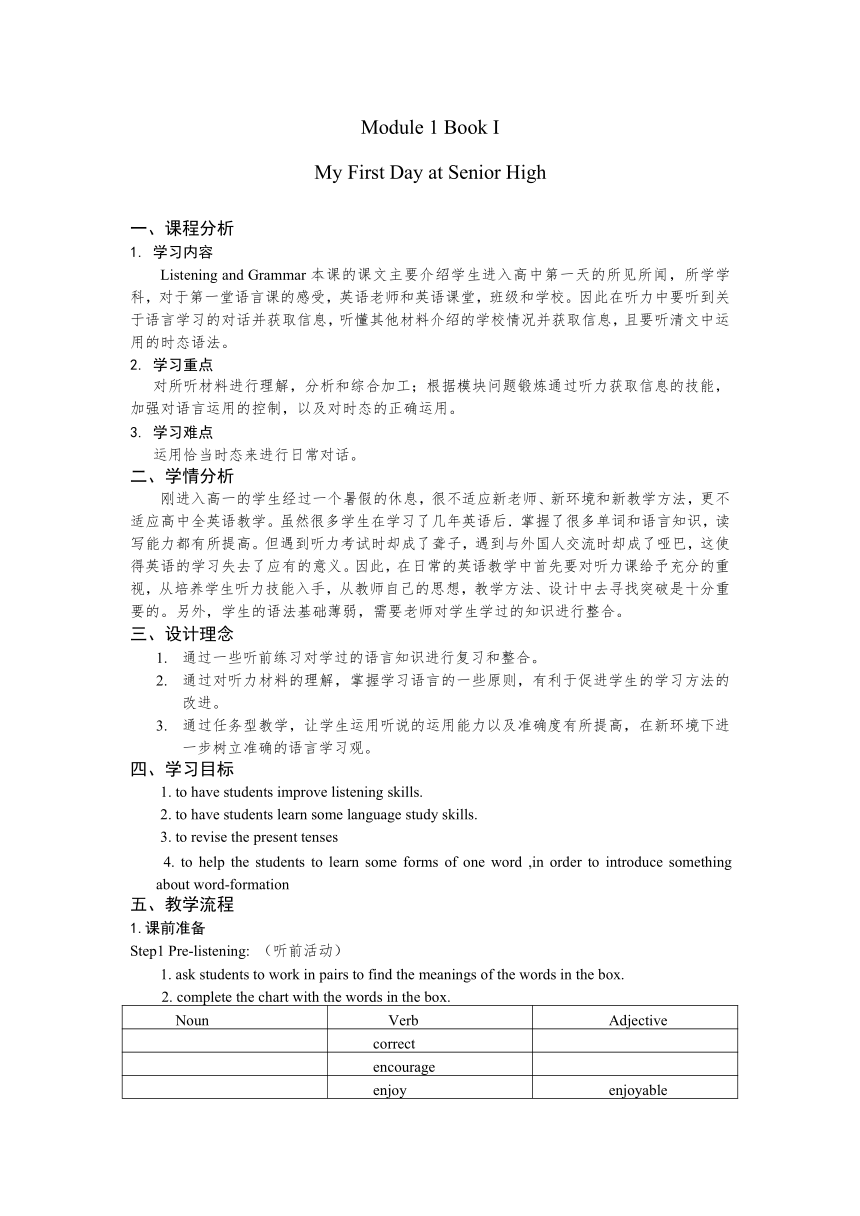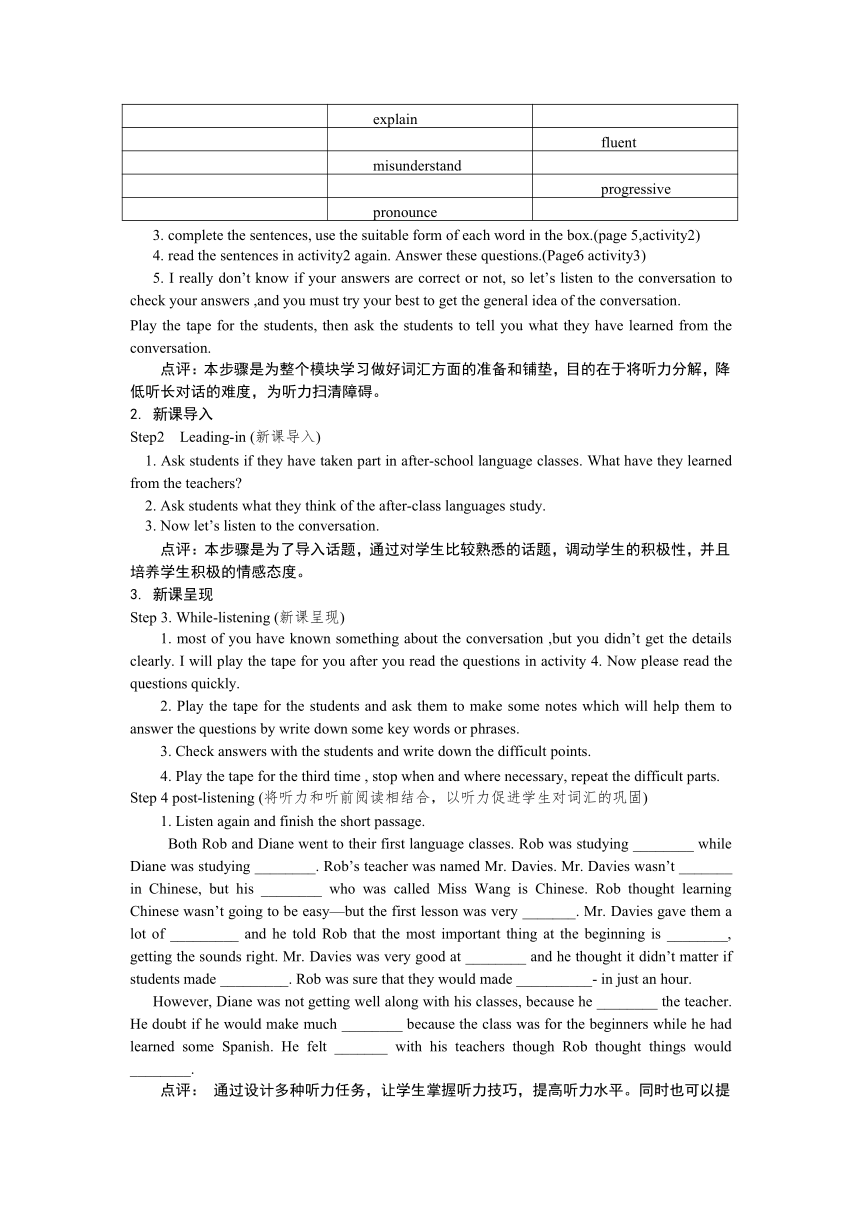外研版英语Book I Module 1 My First Day at Senior High Listening and Grammar 教学设计
文档属性
| 名称 | 外研版英语Book I Module 1 My First Day at Senior High Listening and Grammar 教学设计 |  | |
| 格式 | zip | ||
| 文件大小 | 18.7KB | ||
| 资源类型 | 教案 | ||
| 版本资源 | 外研版 | ||
| 科目 | 英语 | ||
| 更新时间 | 2016-09-04 12:12:46 | ||
图片预览


文档简介
Module
1
Book
I
My
First
Day
at
Senior
High
一、课程分析
1.
学习内容
Listening
and
Grammar本课的课文主要介绍学生进入高中第一天的所见所闻,所学学科,对于第一堂语言课的感受,英语老师和英语课堂,班级和学校。因此在听力中要听到关于语言学习的对话并获取信息,听懂其他材料介绍的学校情况并获取信息,且要听清文中运用的时态语法。
2.
学习重点
对所听材料进行理解,分析和综合加工;根据模块问题锻炼通过听力获取信息的技能,加强对语言运用的控制,以及对时态的正确运用。
3.
学习难点
运用恰当时态来进行日常对话。
二、学情分析
刚进入高一的学生经过一个暑假的休息,很不适应新老师、新环境和新教学方法,更不适应高中全英语教学。虽然很多学生在学习了几年英语后.掌握了很多单词和语言知识,读写能力都有所提高。但遇到听力考试时却成了聋子,遇到与外国人交流时却成了哑巴,这使得英语的学习失去了应有的意义。因此,在日常的英语教学中首先要对听力课给予充分的重视,从培养学生听力技能入手,从教师自己的思想,教学方法、设计中去寻找突破是十分重要的。另外,学生的语法基础薄弱,需要老师对学生学过的知识进行整合。
三、设计理念
通过一些听前练习对学过的语言知识进行复习和整合。
通过对听力材料的理解,掌握学习语言的一些原则,有利于促进学生的学习方法的改进。
通过任务型教学,让学生运用听说的运用能力以及准确度有所提高,在新环境下进一步树立准确的语言学习观。
四、学习目标
1.
to
have
students
improve
listening
skills.
2.
to
have
students
learn
some
language
study
skills.
3.
to
revise
the
present
tenses
4.
to
help
the
students
to
learn
some
forms
of
one
word
,in
order
to
introduce
something
about
word-formation
五、教学流程
1.课前准备
Step1
Pre-listening:
(听前活动)
1.
ask
students
to
work
in
pairs
to
find
the
meanings
of
the
words
in
the
box.
2.
complete
the
chart
with
the
words
in
the
box.
Noun
Verb
Adjective
correct
encourage
enjoy
enjoyable
explain
fluent
misunderstand
progressive
pronounce
3.
complete
the
sentences,
use
the
suitable
form
of
each
word
in
the
box.(page
5,activity2)
4.
read
the
sentences
in
activity2
again.
Answer
these
questions.(Page6
activity3)
5.
I
really
don’t
know
if
your
answers
are
correct
or
not,
so
let’s
listen
to
the
conversation
to
check
your
answers
,and
you
must
try
your
best
to
get
the
general
idea
of
the
conversation.
Play
the
tape
for
the
students,
then
ask
the
students
to
tell
you
what
they
have
learned
from
the
conversation.
点评:本步骤是为整个模块学习做好词汇方面的准备和铺垫,目的在于将听力分解,降低听长对话的难度,为听力扫清障碍。
2.
新课导入
Step2
Leading-in
(新课导入)
1.
Ask
students
if
they
have
taken
part
in
after-school
language
classes.
What
have
they
learned
from
the
teachers
2.
Ask
students
what
they
think
of
the
after-class
languages
study.
3.
Now
let’s
listen
to
the
conversation.
点评:本步骤是为了导入话题,通过对学生比较熟悉的话题,调动学生的积极性,并且培养学生积极的情感态度。
3.
新课呈现
Step
3.
While-listening
(新课呈现)
1.
most
of
you
have
known
something
about
the
conversation
,but
you
didn’t
get
the
details
clearly.
I
will
play
the
tape
for
you
after
you
read
the
questions
in
activity
4.
Now
please
read
the
questions
quickly.
2.
Play
the
tape
for
the
students
and
ask
them
to
make
some
notes
which
will
help
them
to
answer
the
questions
by
write
down
some
key
words
or
phrases.
3.
Check
answers
with
the
students
and
write
down
the
difficult
points.
4.
Play
the
tape
for
the
third
time
,
stop
when
and
where
necessary,
repeat
the
difficult
parts.
Step
4
post-listening
(将听力和听前阅读相结合,以听力促进学生对词汇的巩固)
1.
Listen
again
and
finish
the
short
passage.
Both
Rob
and
Diane
went
to
their
first
language
classes.
Rob
was
studying
________
while
Diane
was
studying
________.
Rob’s
teacher
was
named
Mr.
Davies.
Mr.
Davies
wasn’t
_______
in
Chinese,
but
his
________
who
was
called
Miss
Wang
is
Chinese.
Rob
thought
learning
Chinese
wasn’t
going
to
be
easy—but
the
first
lesson
was
very
_______.
Mr.
Davies
gave
them
a
lot
of
_________
and
he
told
Rob
that
the
most
important
thing
at
the
beginning
is
________,
getting
the
sounds
right.
Mr.
Davies
was
very
good
at
________
and
he
thought
it
didn’t
matter
if
students
made
_________.
Rob
was
sure
that
they
would
made
__________-
in
just
an
hour.
However,
Diane
was
not
getting
well
along
with
his
classes,
because
he
________
the
teacher.
He
doubt
if
he
would
make
much
________
because
the
class
was
for
the
beginners
while
he
had
learned
some
Spanish.
He
felt
_______
with
his
teachers
though
Rob
thought
things
would
________.
点评:
通过设计多种听力任务,让学生掌握听力技巧,提高听力水平。同时也可以提高学生继续练习听力的信心,有利于学生的发展。
Step
4.
Grammar
1.Lead
in
There
are
two
sentences
in
the
passage
“My
first
day
at
Senior
High”
1)
I
live
in
Shijiazhuang,
a
city
not
far
from
Beijing
.
2)
I
am
writing
down
my
thoughts
about
it.
What
are
the
tense
differences
are
there
between
these
two
sentences
Ask
the
students
to
analyze
the
tenses.
点评:
让学生通过对学习过的句子进行对比,分析各个时态之间的区别,注意各个时态运用的场合。
2.
Grammar
study
Today
we
will
revise
the
uses
of
the
present
tenses.
One
is
the
present
simple
tense;
the
other
is
the
present
continuous
tense.
Now
let’s
look
at
some
examples:
(I)
She
visits
her
parents
everyday.
What
is
the
time
by
your
watch
The
moon
goes
around
the
earth.
The
train
leaves
at
seven
and
arrives
at
nine.
We
will
go
to
the
park
if
it
doesn’t
rain
tomorrow.
Please
tell
him
about
it
as
soon
as
he
comes
back.
(II)
All
the
students
are
looking
at
the
blackboard
carefully.
We
are
learning
New
Standard
English.
Now
we
are
leaving
the
classroom
and
approaching
the
playground.
She
is
always
thinking
of
herself.
Ask
the
students
to
analyze
the
examples
and
try
to
find
out
the
principles
of
the
uses
of
the
present
simple
tense
&
the
present
continuous
tense.
点评:
让学生动脑去思考,动手去归纳,发现语法规律,由于这些规律来自于学生自己,而不是老师,因此印象更深刻,学习效果更好。
3.
Conclusion
Summarize
the
uses
of
the
two
tenses
from
the
students.
一般现在时考查要点:
①表示客观事实或普通真理(不受时态限制)
The
geography
teacher
told
us
the
earth
moves
around
the
sun.
②表示现状、性质、状态时多用系动词或状态动词;表示经常或习惯性的动作,多用动作动词,且常与表频率的时间状语连用。
We
always
care
for
each
other
and
help
each
other.
③表示知觉、态度、感情、某种抽象的关系或概念的词常用一般现在时:see、hear、smell、taste、feel、notice、agree、believe、like、hate、want、think、belong
seem等。如:
I
know
what
you
mean.
④在时间、条件状语从句中常用一般现在时代替将来时。但要注意由if
引导的条件状语从句中可以用shall或will表“意愿”,但不表示时态。
If
you
will
accept
my
invitation
and
come
to
our
party,
my
family
will
be
pleased.如果你愿意接受并参加我们的舞会,我的家人会非常高兴。
⑤少数用于表示起止的动词如come、go、leave、arrive、fly、return、start、begin、pen、close、end、stop等常用一般现在时代替将来时,表示一个按规定、计划或安排要发生的动作。当be表示根据时间或事先安排,肯定会出现的状态,只用一般现在时。
The
shop
closes
at
11:00
p.m.
every
day.
Tomorrow
is
Wednesday.
现在进行时考查要点:
①表示说话时正在发生着的一个动作;表示现阶段但不一定是发生在讲话时;表近期特定的安排或计划;go、come等起止动作可用进行时代替将来时。如:
It
is
raining
now.
He
is
teaching
English
and
learning
Chinese.
The
girl
is
always
talking
loud
in
public.(与always、often等频度副词连用,表经常反复的行动或某种感彩)
②下面四类动词不宜用现在进行时。
(A)表示心理状态、情感的动作:like,
love,
hate,
care,
remember,
believe,
want,
mind,
wish,
agree,
mean,
need。
(B)表存在的状态的动词:appear,
exist,
lie,
remain,
seem
belong
to,
depend
on。(C)表示一时性动作的动词:allow,
accept,
permit,
promise,
admit,
complete。(D)表示感官的动词:see,
hear,
notice,
feel,
smell,
sound,
taste,
look。
4.
Practice
Ask
the
students
to
read
a
passage
and
choose
sentences
in
the
present
simple
tense
and
in
the
present
continuous
tense.
Say
which
uses
they
show.
点评:通过讨论任务,让学生学会对各种语法的运用情况进行分析,充分发挥学生的主动性,培养学生发现问题、提出问题、分析问题的能力。
Step
7
Homework
1.
Remember
the
words
and
the
sentences
in
Listening
and
vocabulary.
2.
Try
to
find
some
other
principles
of
word-formation.
点评:此作业是对学生所学内容的一种有效的落实和检查,有利于学生综合英语语言运用能力的提高。
六、课后反思
听力和语法是学生在语言学习过程中的薄弱环节,很多学生在学习过程中容易忽视对听力和语法的学习,而这部分又是教师教学过程中的重点。在日常的英语教学中首先要对听力课给予充分的重视,从培养学生听力技能入手,从教师自己的思想,教学方法、设计中去寻找突破是十分重要的。另外,学生的语法基础薄弱,需要老师对学生学过的知识进行整合。本堂课最成功的部分就是让学生自主的对语法用法进行探究,从而培养学生的自主学习的能力。
七、总体点评
课堂教学活动从学生的兴趣和认知能力出发,按照一定认知规律,从易到难,有层次地展开教学活动。课堂活动覆盖面大,充分调动了全体学生的学习积极性,让所有学生“动”起来,在任务的履行过程中,以参与、体验、互动、交流、合作的学习方式,充分发挥学生自身的认知能力,改变了“教师滔滔讲,学生默默听”,所学知识不能服务于实践的现象。
点评人:童明强
1
Book
I
My
First
Day
at
Senior
High
一、课程分析
1.
学习内容
Listening
and
Grammar本课的课文主要介绍学生进入高中第一天的所见所闻,所学学科,对于第一堂语言课的感受,英语老师和英语课堂,班级和学校。因此在听力中要听到关于语言学习的对话并获取信息,听懂其他材料介绍的学校情况并获取信息,且要听清文中运用的时态语法。
2.
学习重点
对所听材料进行理解,分析和综合加工;根据模块问题锻炼通过听力获取信息的技能,加强对语言运用的控制,以及对时态的正确运用。
3.
学习难点
运用恰当时态来进行日常对话。
二、学情分析
刚进入高一的学生经过一个暑假的休息,很不适应新老师、新环境和新教学方法,更不适应高中全英语教学。虽然很多学生在学习了几年英语后.掌握了很多单词和语言知识,读写能力都有所提高。但遇到听力考试时却成了聋子,遇到与外国人交流时却成了哑巴,这使得英语的学习失去了应有的意义。因此,在日常的英语教学中首先要对听力课给予充分的重视,从培养学生听力技能入手,从教师自己的思想,教学方法、设计中去寻找突破是十分重要的。另外,学生的语法基础薄弱,需要老师对学生学过的知识进行整合。
三、设计理念
通过一些听前练习对学过的语言知识进行复习和整合。
通过对听力材料的理解,掌握学习语言的一些原则,有利于促进学生的学习方法的改进。
通过任务型教学,让学生运用听说的运用能力以及准确度有所提高,在新环境下进一步树立准确的语言学习观。
四、学习目标
1.
to
have
students
improve
listening
skills.
2.
to
have
students
learn
some
language
study
skills.
3.
to
revise
the
present
tenses
4.
to
help
the
students
to
learn
some
forms
of
one
word
,in
order
to
introduce
something
about
word-formation
五、教学流程
1.课前准备
Step1
Pre-listening:
(听前活动)
1.
ask
students
to
work
in
pairs
to
find
the
meanings
of
the
words
in
the
box.
2.
complete
the
chart
with
the
words
in
the
box.
Noun
Verb
Adjective
correct
encourage
enjoy
enjoyable
explain
fluent
misunderstand
progressive
pronounce
3.
complete
the
sentences,
use
the
suitable
form
of
each
word
in
the
box.(page
5,activity2)
4.
read
the
sentences
in
activity2
again.
Answer
these
questions.(Page6
activity3)
5.
I
really
don’t
know
if
your
answers
are
correct
or
not,
so
let’s
listen
to
the
conversation
to
check
your
answers
,and
you
must
try
your
best
to
get
the
general
idea
of
the
conversation.
Play
the
tape
for
the
students,
then
ask
the
students
to
tell
you
what
they
have
learned
from
the
conversation.
点评:本步骤是为整个模块学习做好词汇方面的准备和铺垫,目的在于将听力分解,降低听长对话的难度,为听力扫清障碍。
2.
新课导入
Step2
Leading-in
(新课导入)
1.
Ask
students
if
they
have
taken
part
in
after-school
language
classes.
What
have
they
learned
from
the
teachers
2.
Ask
students
what
they
think
of
the
after-class
languages
study.
3.
Now
let’s
listen
to
the
conversation.
点评:本步骤是为了导入话题,通过对学生比较熟悉的话题,调动学生的积极性,并且培养学生积极的情感态度。
3.
新课呈现
Step
3.
While-listening
(新课呈现)
1.
most
of
you
have
known
something
about
the
conversation
,but
you
didn’t
get
the
details
clearly.
I
will
play
the
tape
for
you
after
you
read
the
questions
in
activity
4.
Now
please
read
the
questions
quickly.
2.
Play
the
tape
for
the
students
and
ask
them
to
make
some
notes
which
will
help
them
to
answer
the
questions
by
write
down
some
key
words
or
phrases.
3.
Check
answers
with
the
students
and
write
down
the
difficult
points.
4.
Play
the
tape
for
the
third
time
,
stop
when
and
where
necessary,
repeat
the
difficult
parts.
Step
4
post-listening
(将听力和听前阅读相结合,以听力促进学生对词汇的巩固)
1.
Listen
again
and
finish
the
short
passage.
Both
Rob
and
Diane
went
to
their
first
language
classes.
Rob
was
studying
________
while
Diane
was
studying
________.
Rob’s
teacher
was
named
Mr.
Davies.
Mr.
Davies
wasn’t
_______
in
Chinese,
but
his
________
who
was
called
Miss
Wang
is
Chinese.
Rob
thought
learning
Chinese
wasn’t
going
to
be
easy—but
the
first
lesson
was
very
_______.
Mr.
Davies
gave
them
a
lot
of
_________
and
he
told
Rob
that
the
most
important
thing
at
the
beginning
is
________,
getting
the
sounds
right.
Mr.
Davies
was
very
good
at
________
and
he
thought
it
didn’t
matter
if
students
made
_________.
Rob
was
sure
that
they
would
made
__________-
in
just
an
hour.
However,
Diane
was
not
getting
well
along
with
his
classes,
because
he
________
the
teacher.
He
doubt
if
he
would
make
much
________
because
the
class
was
for
the
beginners
while
he
had
learned
some
Spanish.
He
felt
_______
with
his
teachers
though
Rob
thought
things
would
________.
点评:
通过设计多种听力任务,让学生掌握听力技巧,提高听力水平。同时也可以提高学生继续练习听力的信心,有利于学生的发展。
Step
4.
Grammar
1.Lead
in
There
are
two
sentences
in
the
passage
“My
first
day
at
Senior
High”
1)
I
live
in
Shijiazhuang,
a
city
not
far
from
Beijing
.
2)
I
am
writing
down
my
thoughts
about
it.
What
are
the
tense
differences
are
there
between
these
two
sentences
Ask
the
students
to
analyze
the
tenses.
点评:
让学生通过对学习过的句子进行对比,分析各个时态之间的区别,注意各个时态运用的场合。
2.
Grammar
study
Today
we
will
revise
the
uses
of
the
present
tenses.
One
is
the
present
simple
tense;
the
other
is
the
present
continuous
tense.
Now
let’s
look
at
some
examples:
(I)
She
visits
her
parents
everyday.
What
is
the
time
by
your
watch
The
moon
goes
around
the
earth.
The
train
leaves
at
seven
and
arrives
at
nine.
We
will
go
to
the
park
if
it
doesn’t
rain
tomorrow.
Please
tell
him
about
it
as
soon
as
he
comes
back.
(II)
All
the
students
are
looking
at
the
blackboard
carefully.
We
are
learning
New
Standard
English.
Now
we
are
leaving
the
classroom
and
approaching
the
playground.
She
is
always
thinking
of
herself.
Ask
the
students
to
analyze
the
examples
and
try
to
find
out
the
principles
of
the
uses
of
the
present
simple
tense
&
the
present
continuous
tense.
点评:
让学生动脑去思考,动手去归纳,发现语法规律,由于这些规律来自于学生自己,而不是老师,因此印象更深刻,学习效果更好。
3.
Conclusion
Summarize
the
uses
of
the
two
tenses
from
the
students.
一般现在时考查要点:
①表示客观事实或普通真理(不受时态限制)
The
geography
teacher
told
us
the
earth
moves
around
the
sun.
②表示现状、性质、状态时多用系动词或状态动词;表示经常或习惯性的动作,多用动作动词,且常与表频率的时间状语连用。
We
always
care
for
each
other
and
help
each
other.
③表示知觉、态度、感情、某种抽象的关系或概念的词常用一般现在时:see、hear、smell、taste、feel、notice、agree、believe、like、hate、want、think、belong
seem等。如:
I
know
what
you
mean.
④在时间、条件状语从句中常用一般现在时代替将来时。但要注意由if
引导的条件状语从句中可以用shall或will表“意愿”,但不表示时态。
If
you
will
accept
my
invitation
and
come
to
our
party,
my
family
will
be
pleased.如果你愿意接受并参加我们的舞会,我的家人会非常高兴。
⑤少数用于表示起止的动词如come、go、leave、arrive、fly、return、start、begin、pen、close、end、stop等常用一般现在时代替将来时,表示一个按规定、计划或安排要发生的动作。当be表示根据时间或事先安排,肯定会出现的状态,只用一般现在时。
The
shop
closes
at
11:00
p.m.
every
day.
Tomorrow
is
Wednesday.
现在进行时考查要点:
①表示说话时正在发生着的一个动作;表示现阶段但不一定是发生在讲话时;表近期特定的安排或计划;go、come等起止动作可用进行时代替将来时。如:
It
is
raining
now.
He
is
teaching
English
and
learning
Chinese.
The
girl
is
always
talking
loud
in
public.(与always、often等频度副词连用,表经常反复的行动或某种感彩)
②下面四类动词不宜用现在进行时。
(A)表示心理状态、情感的动作:like,
love,
hate,
care,
remember,
believe,
want,
mind,
wish,
agree,
mean,
need。
(B)表存在的状态的动词:appear,
exist,
lie,
remain,
seem
belong
to,
depend
on。(C)表示一时性动作的动词:allow,
accept,
permit,
promise,
admit,
complete。(D)表示感官的动词:see,
hear,
notice,
feel,
smell,
sound,
taste,
look。
4.
Practice
Ask
the
students
to
read
a
passage
and
choose
sentences
in
the
present
simple
tense
and
in
the
present
continuous
tense.
Say
which
uses
they
show.
点评:通过讨论任务,让学生学会对各种语法的运用情况进行分析,充分发挥学生的主动性,培养学生发现问题、提出问题、分析问题的能力。
Step
7
Homework
1.
Remember
the
words
and
the
sentences
in
Listening
and
vocabulary.
2.
Try
to
find
some
other
principles
of
word-formation.
点评:此作业是对学生所学内容的一种有效的落实和检查,有利于学生综合英语语言运用能力的提高。
六、课后反思
听力和语法是学生在语言学习过程中的薄弱环节,很多学生在学习过程中容易忽视对听力和语法的学习,而这部分又是教师教学过程中的重点。在日常的英语教学中首先要对听力课给予充分的重视,从培养学生听力技能入手,从教师自己的思想,教学方法、设计中去寻找突破是十分重要的。另外,学生的语法基础薄弱,需要老师对学生学过的知识进行整合。本堂课最成功的部分就是让学生自主的对语法用法进行探究,从而培养学生的自主学习的能力。
七、总体点评
课堂教学活动从学生的兴趣和认知能力出发,按照一定认知规律,从易到难,有层次地展开教学活动。课堂活动覆盖面大,充分调动了全体学生的学习积极性,让所有学生“动”起来,在任务的履行过程中,以参与、体验、互动、交流、合作的学习方式,充分发挥学生自身的认知能力,改变了“教师滔滔讲,学生默默听”,所学知识不能服务于实践的现象。
点评人:童明强
